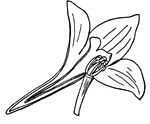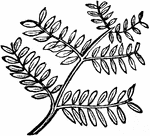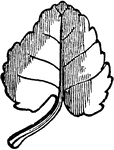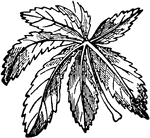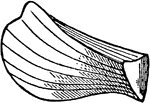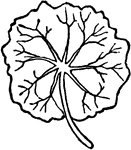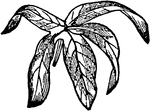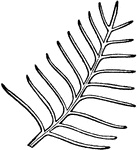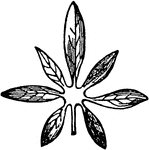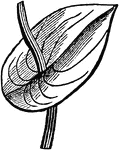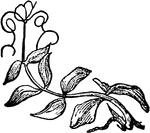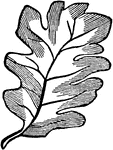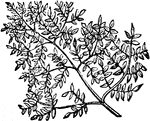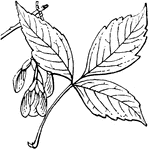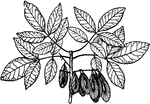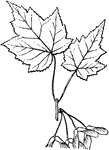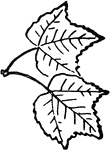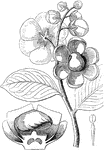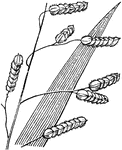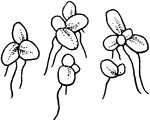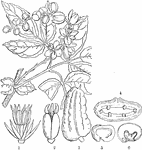
Lardizabala
"Lardizabala triternata. 1. petals and stamens of male flower; 2. carpels; 3. fruit of a Lardizabala;…

Branch of Large-Tooth Aspen
Also known as Populus grandidentata. The branch of a Large-Tooth Aspen, native to eastern North America.
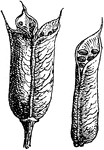
Larkspur Follicle
"Follicle. Fruit of Larkspur. A dry one-celled seed-vessel consisting of a single carpel, and dehiscent…

Dwarf Larkspur
The Delphinium tricorne or Dwarf Larkspur: "1. petals and stamens; 2. carpels; 3. a branch of ripe fruit."…
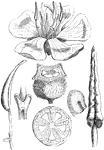
Native Lassiandra
"Melastoma polyanthum. 1. flower; 2, 2. stamens; 3. base of anther; 4. fruit; 5. section of ditto; 6.…
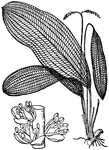
Lattice Leaf
Lattice Leaf is the popular name of a water plant, 'Aponogeton jenestralis', belonging to the order…
Lattice Leaf Plant
"1. Leaf of Ouvirandra fenestralis; 2. a flower cut open; 3. section of a ripe carpel of O. Bernieriana;…

Laurel Dodder
"Cassytha filiformis. 1. a flower; 2. a fruit; 3. a section of it transversely." -Lindley, 1853

Branch of Lawson's Cypress
Also known as Chamaecyparis lawsoniana. Native to the southwest of Oregon to the far northwest of California.
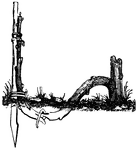
Layering Method of Plant Propagation
Layering is a method of plant propagation by which a part of the plant is bent down and covered with…

Leaf Cuttings
Plant propagation is the process of artificially or naturally distributing plants. Pictured here is…

Leaf Lichen
"A greatly magnified view of a perpendicular section of Parmelia aipolia, showing the thecae in the…

Cross-section of a leaf
Cross section of a leaf, showing the breathing pores and intercellular spaces. The small dots are grains…

Fork-Veined Leaf
"Fork-veined leaves are those in which the primary veins divide into two nearly equal secondary veins,…
Lanceolate Leaf
"Lanceolate, when it is three or more times as long as it is broad, and rounded at the base, and tapering…

Ovate Leaf
"It is said to be ovate when it has the outline of the longitudinal section of an egg."—Darby,…
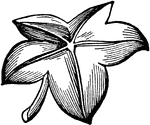
Peltate Leaf
"Peltate, with the petiole inserted in the lamina, but not in the center of it."—Darby, 1855

Ruccinate Leaf
"Ruccinate, when the divisions of a pinnatifid leaf are more or less triangular, and pointing downwards."—Darby,…

Leaves Derived from the Oval Type
This illustration shows leaves derived from the oval type: 13. Ovate and Serrate; 14. Palmately three…
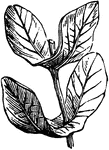
Connate Leaves
A leaf in which the lower lobes are uniteed, either above the stem is sessile or above the petiole if…

Parallel-Veined Leaves
"Parallel-veined leaves are those in which the veins proceed from their origin to their termination…

Lechenaultia
"Leschenaultia splendens. 1. calyx, stamens, and style, with stigma and indusium, all magnified." -Lindley,…
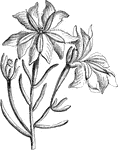
Blue Lechenaultia
Leschenaultia biloba or the blue lechenaultia is a flowering plant of the Goodeniaceae family.
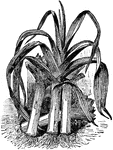
London Flag Leek
"A hardy biennial plant, producing an oblong bulb, or stalk, which has the flavor of an onion, and is…
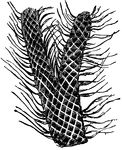
Portion of Lepidodendron
This illustration shows a portion of Lepidodendron. Lepidodendron is the generic name of a large and…
